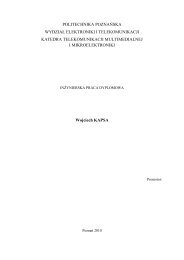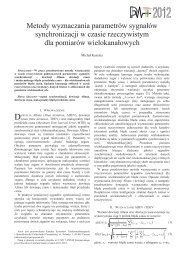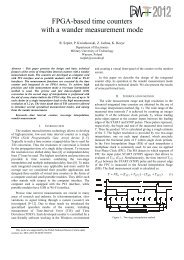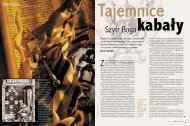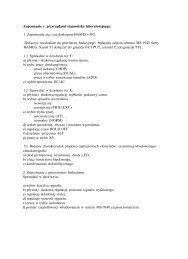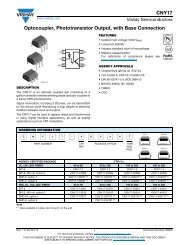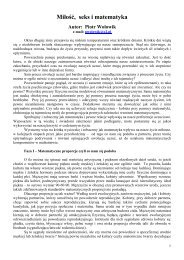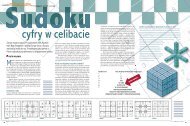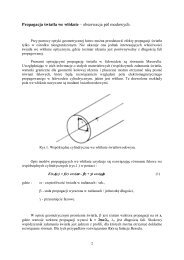WIRELESS
Dynamic Channel Modeling at 2.4 GHz for On-Body Area Networks
Dynamic Channel Modeling at 2.4 GHz for On-Body Area Networks
Create successful ePaper yourself
Turn your PDF publications into a flip-book with our unique Google optimized e-Paper software.
22 ADVANCES IN ELECTRONICS AND TELECOMMUNICATIONS, VOL. 2, NO. 4, DECEMBER 2011<br />
TABLE II<br />
TX ON HIP: CHANNEL GAIN AND SHADOWING PARAMETERS IN DB,<br />
MEASUREMENT CAMPAIGN 2<br />
30<br />
25<br />
Anechoic Chamber<br />
Indoor<br />
Still<br />
Walking<br />
Anechoic Chamber<br />
Indoor<br />
RX on µ 0S σ 0S σ SS µ 0S σ 0S σ SS<br />
Chest -60.88 4.15 0.61 -54.65 4.81 0.60<br />
Thigh -64.31 1.54 0.41 -60.71 2.62 0.24<br />
R Wrist -63.21 2.61 0.95 -57.86 5.10 0.26<br />
R Foot -67.12 5.18 0.41 -60.44 2.26 0.24<br />
Chest -53.37 7.86 2.15 -51.75 7.27 1.52<br />
Thigh -61.97 6.49 5.27 -59.48 3.04 3.27<br />
R Wrist -62.17 5.96 4.31 -59.59 4.20 2.66<br />
R Foot -68.60 7.41 4.97 -58.33 2.59 2.57<br />
Rice K−factor<br />
20<br />
15<br />
10<br />
5<br />
0<br />
30<br />
25<br />
Hip−Chest Hip−Thigh Hip−Wrist Hip−Foot<br />
Link<br />
(a)<br />
Anechoic Chamber<br />
Indoor<br />
Running<br />
Chest -52.78 3.34 2.39 -47.94 7.54 2.00<br />
Thigh -59.12 4.43 2.47 -57.84 3.52 1.98<br />
R Wrist -65.86 4.31 3.49 -61.78 3.89 2.37<br />
R Foot -71.22 8.43 2.69 -60.47 1.96 1.80<br />
Rice K−factor<br />
20<br />
15<br />
10<br />
TABLE III<br />
TX ON LEFT EAR: CHANNEL GAIN AND SHADOWING PARAMETERS IN DB,<br />
MEASUREMENT CAMPAIGN 2<br />
Still<br />
Walking<br />
Running<br />
Anechoic Chamber<br />
Indoor<br />
RX on µ 0S σ 0S σ SS µ 0S σ 0S σ SS<br />
R. Ear -63.25 6.35 0.23 -60.22 3.15 0.21<br />
Hip -60.13 8.94 0.45 -60.28 6.07 0.28<br />
R. Wrist -72.9 2.63 1.15 -64.47 3.28 0.31<br />
R. Foot -75.35 4.53 0.56 -62.72 2.19 0.3<br />
R. Ear -61.00 2.7 0.54 -60.03 3.08 0.9<br />
Hip -57.93 7.17 2.07 -58.77 4.94 2.2<br />
R. Wrist -71.85 2.91 3.35 -63.04 1.98 1.8<br />
R. Foot -72.99 4.65 4.21 -61.00 1.31 2.02<br />
R. Ear -61.36 3.64 0.52 -60.74 5.3 0.7<br />
Hip -63.83 7.54 2.82 -60.76 5.7 2.19<br />
R. Wrist -71.99 2.22 2.98 -63.56 2.23 1.88<br />
R. Foot -77.7 3.42 1.57 -62.70 1.15 1.24<br />
distribution into a Rayleigh distribution.<br />
The off-body scattering effect and the increasing number of<br />
MPCs in indoors also enhance the fast fading. These effects<br />
are directly transposed on the statistics of |η(t n )| and the K<br />
factors. In Fig. 7 we compare the K factor of the fast fading<br />
distribution in indoors and in anechoic chamber. It shows that<br />
the K factor in indoors is sensibly lower than in anechoic<br />
chamber, which describes a more important contribution from<br />
the NLOS propagation components.<br />
IV. DOPPLER DISPERSION<br />
The Doppler spectra were investigated and modeled in measurement<br />
campaign 2 in [16]. Fig. 8 presents the normalized<br />
Doppler spectra in walking scenarios in anechoic chamber.<br />
When one node is on the trunk and the other one is on<br />
a moving limb, the Tx-Rx distance changes slightly during<br />
the body movements. However, the relative velocity of the<br />
Rx to the Tx is low, and the time-variance of the Tx-Rx<br />
distance is mainly given by the varying postures of the body.<br />
Consequently the Doppler spectrum is still centered at f ν = 0,<br />
5<br />
0<br />
L. Ear−R. Ear L. Ear−Hip L. Ear−Wrist L. Ear−Foot<br />
Link<br />
(b)<br />
Fig. 7. K factor in Walking scenarios, measurement campaign 2: TX on hip<br />
(a) and on the left ear (b)<br />
Norm. Doppler Spectrum [dB]<br />
0<br />
−10<br />
−20<br />
−30<br />
−40<br />
−50<br />
Measure Hip−Chest<br />
Model Hip−Chest<br />
Measure Hip−Thigh<br />
Model Hip−Thigh<br />
Measure Hip−Wrist<br />
Model Hip−Wrist<br />
Measure Hip−Foot<br />
Model Hip−Foot<br />
−60<br />
−25 −20 −15 −10 −5 0 5 10 15 20 25<br />
Doppler Frequency Shift [Hz]<br />
Fig. 8. Normalized Doppler Spectra: human walking in anechoic chamber,<br />
measurement campaign 2<br />
f ν as the Doppler frequency shift, but presenting a smoother<br />
behavior, as shown in Fig. 8.<br />
The difference on the floor levels of the Doppler spectra in<br />
Fig. 8, when the Rx is on the chest, and when the Rx is on the<br />
limbs, can be explained by the increased freedom of mobility<br />
in the latter case. Given this behavior it is useful to identify<br />
the Doppler bandwidths by a threshold, e.g. -20 dB below the<br />
peak value at f ν =0 Hz, instead of the maximum Doppler shift.<br />
In Table IV, the results of the Doppler bandwidth in anechoic<br />
chamber are listed.<br />
A rigorous mathematical formulation of Doppler spectrum<br />
from moving scatterers has been recently given in [17]. By



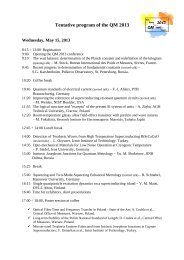


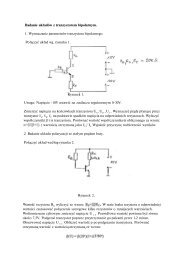
![1RUPDOQH \FLHFKU]H FLMD VNLH](https://img.yumpu.com/54031532/1/184x260/1rupdoqh-flhfkuh-flmd-vnlh.jpg?quality=85)
